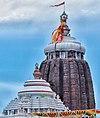| Krupasiddha Matta Balarama Dasa | |
|---|---|
 Statue of Balarama Dasa at Erabanga, his native place Statue of Balarama Dasa at Erabanga, his native place | |
| Native name | ବଳରାମ ଦାସ |
| Born | c. 1472 Puri |
| Died | c. 1556 |
| Occupation | Poet, Saint |
| Language | Odia |
| Genre | Mythology, philosophy, yoga Odissi music |
| Notable works | Jagamohana Ramayana, Lakshmi Purana |
Balarama Dasa (alternatively spelled Balaram Das; Odia: [bɔl̪ɔraːmɔ d̪aːsɔ] ; c. 1474-1522) was an Odia poet and litterateur. He was one of the 5 great poets in Odia literature, the Panchasakha named Sri Ananta Dasa, Sri Jagannatha Dasa, Sri Jasobanta Dasa and Sri Achyutananda Dasa during the Bhakti age of literature. He was the eldest of the Pancha sakha. He wrote the Jagamohana Ramayana also known as Dandi Ramayana.
Personal life
Not much is known about his early life. From his own writings it is known that he was the son of Somanatha Mahapatra and Jamuna Debi who belonged to Karana community. Balarama Dasa hailed from an aristocratic noble family of a minister named Somanatha who belonged to Karana community, his father Somanatha was a devout follower of Lord Jagannath and raised Balarama in a religious environment, Somanatha was known by the name "Mahamantri Somanatha Mohapatra" in Gajapati Empire. Balarama Dasa also served as a minister in Prataparudra Deva's court and originally belonged to the village of Erabanga in Puri district. He was educated and was well versed in Sanskrit. Balarama naturally grew to be proficient in both Odia and Sanskrit. He became a devotee of Jagannatha. In his Middle Ages he came in contact with Chaitanya. Balarama Dasa had left his position of ministership in Prataparudra Deva's court in pursuit of spiritual ideals after being influenced by Chaitanya Mahaprabhu. It is speculated that he died while on a pilgrimage to Puri in Begunia village near Konark. There is a memorial for him near this village.
Literary works

Dasa translated the Ramayana to Odia. It is also known as Jagamohana Ramayana or Dandi Ramayana. More than a translation, the work is a transcreation, as it deviates in many ways from the original. In some parts he goes against the original text and in some parts follows the original text closely and yet in some other parts he creates entirely new narratives.
He also broke new grounds by translating the Bhagabat Gita into Odia. Before this the philosophical and theological texts were not translated into Odia. Even in Odia Mahabharata by Sarala Dasa, the portion containing Bhagabata Gita was omitted by the author. Balarama Dasa was subsequently persecuted by the priestly class for his translation of Bhagabata Gita. His other works are as below.
- Jagamohana Ramayana (Dandi Ramayana)
- Lakshmi Purana
- Bedanta Sara Gupta Gita
- Gupta Gita
- Amarakosa Gita
- Srimad Bhagabad Gita (Odia)
- Bata Abakasa
- Panasa Chori
- Kamala Lochana Chautisa
- Birata Gita
- Baula Adhyaya
- Kanta Koili
- Mruguni Stuti
- Chhatisa Gupta Gita
- Saptanga Jogasara Gita
- Bhaba Samudra
- Garuda Gita
- Ananta Gita
- Arjjuna Gita
- Srabana Sara Gita
- Diptisara Gita
- Uddhaba Gita
- Bedha Parikrama
- Linga Purana
- Kurala Purana
- Brahma Purana
References
- Satpathy, Sumanyu; Nayak, Jatindra K. (2015). ""Mad" Balarama Dasa and His "Rāmāyana"". Indian Literature. 59 (3 (287)): 10–12. ISSN 0019-5804. JSTOR 44478655.
- Bahinipati, Priyadarshi (2017-02-20). Jagamohana Ramayana. The Epic of Balarama Dasa. Anchor Academic Publishing. ISBN 978-3-96067-624-9.
- ^ Mukherjee, S. (1998). A Dictionary of Indian Literature: Beginnings-1850. Orient Longman. p. 35. ISBN 978-81-250-1453-9. Retrieved 2019-08-27.
- ^ St-Pierre, P.; Kar, P.C. (2007). In Translation: Reflections, Refractions, Transformations. Benjamins translation library. John Benjamins Pub. p. 171. ISBN 978-90-272-1679-3. Retrieved 2019-08-27.
- Mukherjee, Prabhat (1981). The History of Medieval Vaishnavism in Orissa. Asian Educational Services. ISBN 978-81-206-0229-8.
- Pradhan, Atul Chandra (1984). A Study of History of Orissa: From the Earliest Times to Mukundadeva. Panchashila.
- Mukherjee, Prabhat (1981). The History of the Gajapati Kings of Orissa and Their Successors. Kitab Mahal.
- Williams, Joanna (2023-12-22). The Two-Headed Deer: Illustrations of the Ramayana in Orissa. Univ of California Press. ISBN 978-0-520-32182-3.
- Citaristi, Ileana (2022-10-06). Odissi and the Geeta Govinda. Taylor & Francis. ISBN 978-1-000-78098-7.
- Dalal, Roshen (2014-04-18). Hinduism: An Alphabetical Guide. Penguin UK. ISBN 978-81-8475-277-9.
- Dasa, Balarama (2017). Sahoo, Dr. Niranjana (ed.). Bhakta Kabi Balarama Dasa Granthabali ଭକ୍ତକବି ବଳରାମ ଦାସ ଗ୍ରନ୍ଥାବଳୀ [Collected works of Bhakta Kabi Balarama Dasa] (in Odia). Vol. 1 (1 ed.). Cuttack, Odisha: Odisha Book Emporium.
- Patnaik, H.S.; Parida, A.N. (1996). Aspects of socio-cultural life in early and medieval Orissa. DSA Programme, Post Graduate Dept. of History, Utkal University. Retrieved 2019-08-27.
- ^ Dalal, R. (2014). Hinduism: An Alphabetical Guide. Penguin Books Limited. p. 260. ISBN 978-81-8475-277-9. Retrieved 2019-08-27.
- Citaristi, Ileana (2022-10-06). Odissi and the Geeta Govinda. Taylor & Francis. ISBN 978-1-000-78098-7.
- Dalal, R. (2014). Hinduism: An Alphabetical Guide. Penguin Books Limited. p. 261. ISBN 978-81-8475-277-9. Retrieved 2019-08-27.
- Paniker, K.A.; Sahitya Akademi (1997). Medieval Indian Literature: Surveys and selections. Sahitya Akademi. p. 401. ISBN 978-81-260-0365-5. Retrieved 2019-08-27.
- ""Panchasakha"-Sri Balaram Das". ReportOdisha.com. 2015-10-28. Retrieved 2019-08-27.
| Jagannath worship | |||||||
|---|---|---|---|---|---|---|---|
| Deities |  | ||||||
| Temples |
| ||||||
| Festivals | |||||||
| Texts | |||||||
| Devotees | |||||||
| See also | |||||||
| Odia literature | |||||||||||||||||
|---|---|---|---|---|---|---|---|---|---|---|---|---|---|---|---|---|---|
| Charya era | |||||||||||||||||
| Pre-Sarala era | |||||||||||||||||
| Sarala era | |||||||||||||||||
| Panchasakha era | |||||||||||||||||
| Reeti era | |||||||||||||||||
| Radhanath era | |||||||||||||||||
| Satyabadi era | |||||||||||||||||
| Sabuja era | |||||||||||||||||
| Pragati era | |||||||||||||||||
| Modern era |
| ||||||||||||||||
